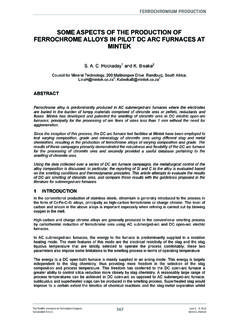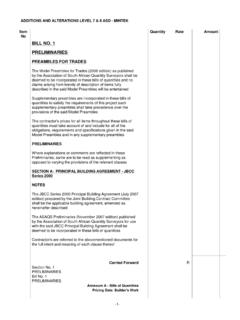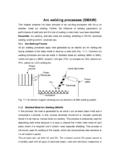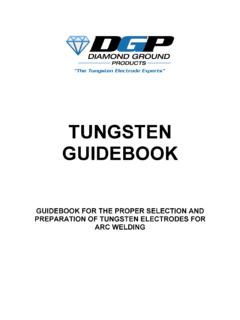Transcription of DC ARC FURNACES – PAST, PRESENT, AND FUTURE
1 DC ARC FURNACES past , present , AND FUTURE Rodney T. Jones Mintek; 200 Malibongwe Drive, Private Bag X3015, Randburg, 2125, South Africa Keywords: Pyrometallurgy, DC arc furnace , electric arc, smelting Abstract DC arc FURNACES were first used industrially for the reductive smelting of chromite fines to produce ferrochromium thirty years ago. Since then, they have been used for a variety of applications, including the smelting of ilmenite to produce titania slag and pig iron, the recovery of cobalt from non-ferrous smelter slags, and the smelting of nickel laterite ores to produce ferronickel. The power of these FURNACES has increased from 12 MW to 72 MW for ferrochromium, and to 80 MW for ferronickel.
2 The largest of these FURNACES requires two electrodes to carry sufficient current to generate this much power. A review is presented of various DC arc FURNACES in use, along with a discussion of the likely ways in which furnace power might be increased further in the FUTURE . Introduction and History Early Description of an Arc by Humphry Davy The earliest known written description of a man-made electric arc emanated from Humphry Davy s work in the early 1800s. His early experiments in 1800, only a few months after Volta s introduction of the electric battery, involved the production of sparks during the making and breaking of an electric circuit. I have found that this substance [well burned charcoal] possesses the same properties as metallic bodies in producing the shock and spark when made a medium of communication between the ends of the galvanic pile of Signor Volta.
3 The spark is most vivid when the charcoal is hot. [1] In his 1812 book, Elements of Chemical Philosophy [2], Sir Humphry Davy provides the first description and diagram (reproduced in Figure 1) of the long horizontal arch of flame that gives the arc its name. Figure 1. Sir Humphry Davy and a horizontal arch electrical discharge, as shown in Davy s Elements of Chemical Philosophy When pieces of charcoal about an inch long and one sixth of an inch in diameter, were brought near each other (within the thirtieth or fortieth part of an inch), a bright spark was produced, and more than half the volume of the charcoal became ignited to whiteness, and by withdrawing the points from each other a constant discharge took place through the heated air, in a space equal at least to four inches, producing a most brilliant ascending arch of light, broad, and conical in form in the middle.
4 When any substance was introduced into this arch, it instantly became ignited; platina melted as readily in it as wax in the flame of a common candle; quartz, the sapphire, magnesia, lime, all entered into fusion; fragments of diamond, and points of charcoal and plumbago, rapidly disappeared, and seemed to evaporate in it, even when the connection was made in a receiver exhausted by the air pump; but there was no evidence of their having previously undergone fusion. [2] DC Arc furnace by Sir William Siemens The idea behind the (direct current) DC arc furnace has been around for a very long time. Its use for the bulk melting of metals dates back at least to 1878, when Sir William Siemens used a DC arc furnace with a vertical graphite cathode, with the arc transferred to the melt in contact with a water-cooled bottom anode (shown in Figure 2) [3].
5 Figure 2. Sir William Siemens and the DC furnace he patented in 1878 About two decades after this, the first AC (alternating current) electric arc furnace , invented by Paul H roult, was patented and first operated in La Praz, France, in 1900. The first AC furnace in the USA was installed in 1906 in Philadelphia. Electric furnace technology became almost entirely AC based thereafter, because of the use of AC for efficient power transmission from large central power stations (following developments by Nikola Tesla and George Westinghouse in 1887 and 1888) and the use of local step-down transformers to supply the high currents required in the FURNACES . Significant commercialisation of DC furnace technology occurred in the 1990s, when there was a huge demand for DC arc FURNACES for steel scrap melting, following the development of high-power solid-state rectifiers.
6 Around that time, about 80 DC arc FURNACES were built in the northern hemisphere. Features of DC Arc FURNACES A DC arc furnace typically comprises a refractory-lined cylindrical steel shell, with a central graphite (cathode) electrode vertically positioned through an opening in the centre of the roof. The anode connection in the hearth of the furnace is in direct contact with the layer of molten metal that is covered by a layer of molten slag. The energy is supplied by means of an open plasma arc that is generated between the bottom tip of the cathode and the upper surface of the molten slag. At least a central portion of the slag surface is open (uncovered by feed material).
7 Because the furnace is electrically powered, very high temperatures (> 1500 C) can be attained. The open bath allows fine feed materials to be fed into the furnace , without risk of blocking the gas emanating from the chemical reactions. (By contrast, in a blast furnace , or in a submerged-arc furnace , coarse feed materials are required in order to provide a porous bed that allows the reaction gases to percolate away and escape from the reaction zone.) Finer ores and a requirement for very high temperature lead one to the choice of an open-arc furnace (either AC or DC). It should be noted that fine ores allow the use of a fluidized-bed reactor for pre-heating or pre-reduction, and this can provide significant energy savings when used in conjunction with a DC arc furnace .
8 In the case of open-arc FURNACES , DC FURNACES have a number of advantages over AC FURNACES . One particular advantage in a circular furnace is that there is no arc repulsion in the case of the single DC arc, compared to the AC case where the arcs repel one another, flaring towards the walls, leading to hot spots on the areas of the side-walls in closest proximity to the electrodes. DC FURNACES also experience lower electrode consumption. In large DC FURNACES , a higher current can be carried per electrode (or smaller electrodes can be used for the same current), because of the AC skin effect where current is concentrated in the outer periphery of the electrodes. Some past and Current Applications of DC Arc FURNACES Early Developments in the Application of DC Arc FURNACES to Chromite Smelting South Africa is very fortunate in having large reserves of chromite.
9 Unfortunately a lot of the Transvaal chromites are highly friable, resulting in large stockpiles of fine ore materials. This posed a particular challenge to Mintek to provide a solution to this problem. Peter Jochens of Mintek identified plasma FURNACES as a possible solution to the chromite fines problem. Mintek and Middelburg Steel & Alloys (now part of Samancor Chrome) conducted smelting trials on Tetronics pilot transferred-arc plasma FURNACES in the UK in 1979/80. These trials showed successful metallurgy, but this type of furnace was seen as difficult to scale up to the very large FURNACES that were required for the ferro-alloys industry. Around about the same time, also in the 1970s, ASEA in Sweden developed high-power thyristor rectifiers.
10 Sven-Einar Stenkvist investigated the conversion of AC open arc FURNACES to DC, principally for steelmaking. He implemented the idea of using a graphite cathode electrode arcing onto a slag/metal bath as the anode, and devised an electrically conductive hearth and a hollow graphite electrode for finely sized iron ore smelting, where the feed material is fed through the electrode and through the heart of the plasma arc. This is shown in Figure 3. Figure 3. ASEA s DC arc furnace Nic Barcza of Mintek recognised the synergy between the metallurgy that was proven during the Tetronics testwork, and the scale-up potential of ASEA s DC arc furnace . This is where the application of pre-baked graphite electrodes in a DC arc furnace came about.













